Odekon M. Encyclopedia of paleoclimatology and ancient environments
Подождите немного. Документ загружается.

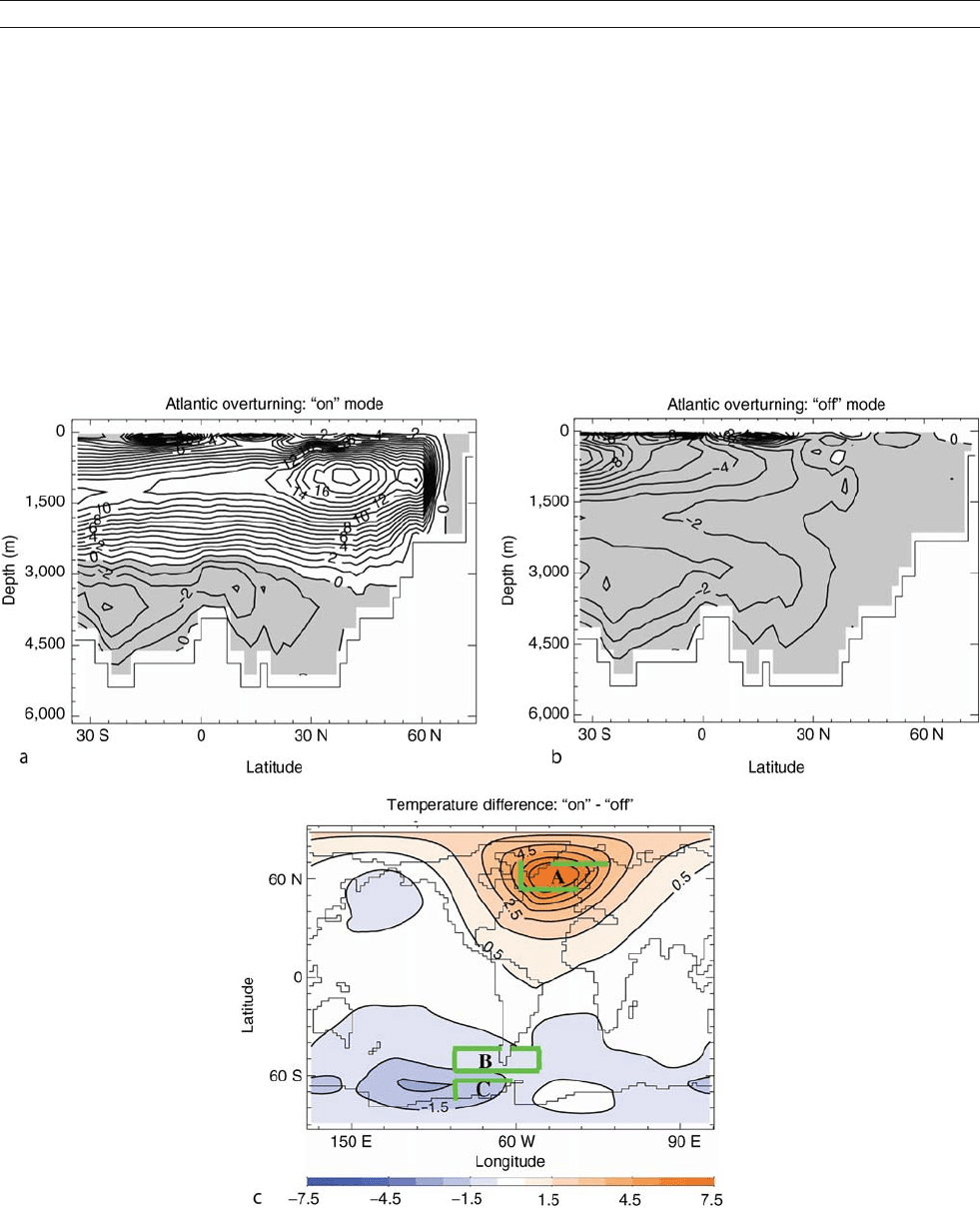
Hysteresis behavior of the MOC
Sea water density is a function of not only temperature, but
also salinity. Furthermore, at low temperatures, such as those
that exist in the deep water formation regions, the density of
sea water is more sensitive to changes in salinity than to
changes in temperature. In addition, throughout the Quaternary,
large quantities of freshwater have been periodically stored
on land at middle to high latitudes in the form of continental
ice sheets. During the growth or melt of these continental ice
sheets, tens of meters of sea level equivalent freshwater have
been taken from or released back to the ocean. As a conse-
quence, numerous studies have been conducted in an attempt
to understand the role of freshwater perturbations on the stabi-
lity of the MOC.
The dependence of sea water density on salinity is a key
player in what is now known as a hysteresis behavior of the
AMO. Recently it has been discovered that the AMO behaves like
a “see-saw,” with relatively warm surface conditions in the
North Atlantic and relatively cool surface conditions in the South
Atlantic occurring when NADW formation is active, and conver-
sely, with relatively cool surface conditions in the North Atlantic
and relatively warm surface conditions in the South Atlantic
occurring when NADW formation is inactive (Figure T2). Such
a finding is supported by both modeling studies, proxy records,
and from combined model/proxy record studies. More recently
still, it has been realized that the “see-saw” nature of the AMO is
fundamentally linked to a coupling between the strength of AAIW
formation and the strength of NADW formation (Figure T3).
Figure T2 Atlantic meridional overturning circulation (Sv) for: (a) the stable active mode of NADW formation; (b) the stable inactive mode of
NADW formation. The inactive mode (b) was obtained by adding freshwater (100 Sv years) to region A. Notice the enhanced intrusion of AAIW
and the absence of NADW in (b). (c) Surface air temperature (
C) difference between the climatic states represented by (a) and (b). Region B in
(c) is where freshwater is added to get the hysteresis of Figure T3, although similar results are found when freshwater is added to region
C. Taken from Weaver et al. (2003).
THERMOHALINE CIRCULATION 945

The meridional overturning circulation and
Quaternary climate change
Early ice core records for the last glaciation have revealed large
amplitude variability on the millennial timescale characterized
by abrupt warming events (interstadials) lasting from several
hundred to several thousand years. These oscillations (Figure T4
and T5), known as Dansgaard-Oeschger (D-O) oscillations,
also appear in North Atlantic sediment records suggesting a
role or response of the ocean. Evidence from the Santa Barbara
basin and the Northeast Pacific suggests that a signature of
these D-O oscillations is also present in the Pacific Ocean,
while further recent sediment analyses suggest they may be
an inherent part of late and early Pleistocene climate.
In an attempt to provide a mechanism for the observed D-O
variability, it was initially proposed that a stable AMO was not
possible during glacial times, when the northern end of the
Atlantic Ocean was surrounded by ice sheets. Furthermore,
when the AMO was weakened or shut down and ice sheets
were growing, there was little oceanic salt export from the
Atlantic to the other ocean basins. Assuming a net evaporation
over the North Atlantic, its salinity continued to increase as
moisture was deposited on land as snow, thereby expanding
the ice sheets. Upon reaching a critical salinity, deep convec-
tion, and subsequently the AMO, turned on, transporting and
releasing heat to the North Atlantic and thereby melting back
the ice sheets. The fresh water flux into the North Atlantic from
the melting ice sheets (or enhanced iceberg calving) eventually
reduced or shut off the AMO, causing the process to begin
anew. This hypothesis fundamentally assumed that most of
the evaporation from the Atlantic basin was balanced by a net
freshwater transport into the Atlantic associated with an active
AMO. While this in itself has not yet been established, it could
be true for a climate with an active AMO. However, it is clear
that the weakening of the AMO would trigger a reorganization
of the circulation in the South Atlantic, but it is not clear
whether this reorganized circulation would be able to balance
the required Atlantic evaporation.
Recent models, including an interactive continental ice
sheet, showed that the earlier mechanism for D-O oscillations
was in fact opposite to what actually occurred within the
coupled system. During the cold, glacial climate, when the
AMO was still active, the mass balance over continental ice
sheets was positive. That is, rather than melting the ice sheets
when the AMO was active, they grew, since the warmer atmo-
sphere allowed greater precipitation (in the form of snow). The
models also found a mechanism for D-O oscillations that
involved an interaction between the AMO and the adjacent
continental ice sheets, by assuming that the rate of iceberg
calving into the North Atlantic was not constant in time, which
is consistent with observations of ice-rafted debris. It was
shown that after a delay of several hundred years following a
major surging event and a reduction of the iceberg calving
rate, the AMO intensified and the North Atlantic experienced
an abrupt shift to a much warmer climate. This mechanism
appears to be more intuitively appealing than a competing
hypothesis involving stochastic resonance of the AMO, which
relies upon the existence of an unknown 1,500 year external
periodic forcing.
Heinrich (1988), in analyzing marine sediments in three
cores from the North Atlantic, noted the presence of six anom-
alous concentrations of lithic fragments over the last glaciation.
Since the source for these fragments was the land (and in
particular Canada), he argued that this provided evidence for
six anomalous surges of icebergs into the North Atlantic
(Figure T5). The so-called Heinrich events (H) were even more
striking when expressed in terms of the ratio of lithic fragments
to the sum of lithic fragments and foraminiferal shells, due to
the low foraminiferal counts in the Heinrich sediment layers.
A simple model illustrates the mechanism for Laurentide Ice
Sheet instability, which ultimately gives rise to an ice-sheet
surge and a Heinrich event. It has been argued that the Heinrich
Figure T3 The UVic Earth System Climate Model (Weaver et al., 2001)
hysteresis of NADW (blue), AAIW (red), and AABW (green), showing: (a)
surface densities in the source regions of these water masses; (b)
maximum (or minimum) MOC cells associated with these water masses.
The model was started from a mode with no NADW formation with
zero externally imposed freshwater flux. A freshwater perturbation was
then applied to the AAIW formation region with a linearly-increasing
rate of 0.2 Sv / 1,000 years. This rate was small enough to ensure a
nearly steady-state system, except for abrupt transitional events. Upon
transition to a mode with active NADW formation, the freshwater
perturbation was reduced at the same rate back to zero, and then to
negative values, in order to trigger a transition from the active to the
inactive mode of NADW formation. To complete the whole hysteresis
loop, the model was integrated for more than 11,000 years. Transitions
between the active and inactive modes of NADW formation occur
when the surface densities at the site of AAIW and NADW formation
cross. Taken from Saenko et al. (2003).
946 THERMOHALINE CIRCULATION
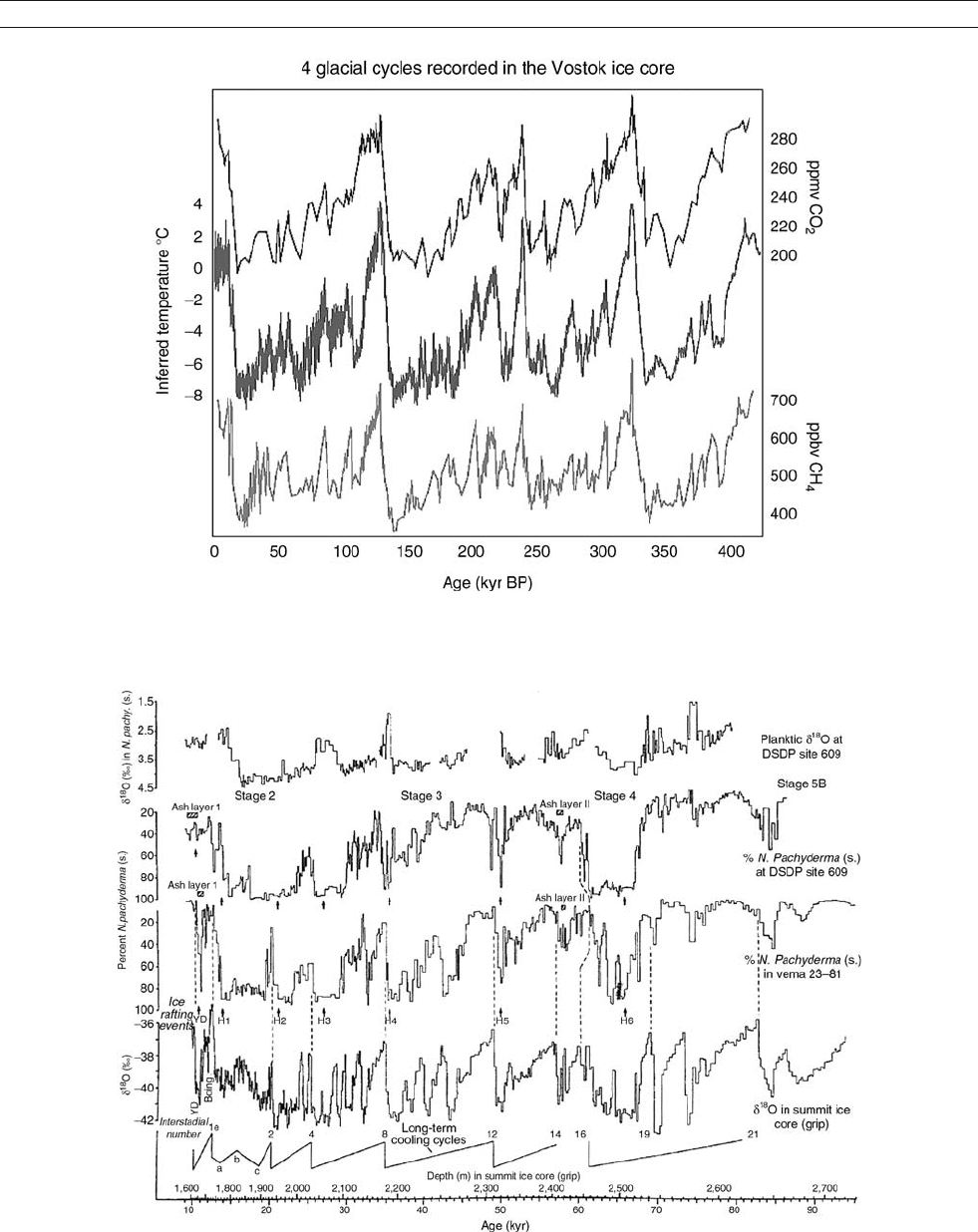
Figure T4 Variations in local Antarctic atmospheric temperature, as derived from oxygen isotope data, as well as concentrations of atmospheric
CO
2
and CH
4
from Vostok, Antarctica ice core records over the last four glacial cycles. The rapid oscillations represent Dansgaard-Oeschger
cycles. Figure redrawn from Petit et al. (1999).
Figure T5 Sediment foraminiferal records from Bond et al. (1993) and ice core oxygen isotope records from Dansgaard et al. (1993) and GRIP
(1993) as correlated by Bond et al. (1993). The Younger Dryas (YD) and six Heinrich events (H1–H6) are indicated. Also shown at the bottom is the
saw tooth Bond Cycle pattern of successively weaker interstadials associated with a sequence of D-O oscillations following a Heinrich event (from
Bond et al., 1993).
THERMOHALINE CIRCULATION 947

cycle consists of two phases. In the growth phase, the Lauren-
tide Ice Sheet grew through snow accumulation while remain-
ing attached to the bedrock. In the purge phase, the high
pressures caused by the deep ice sheet caused thawing near
the base of the ice sheet thereby allowing the ice sheet to surge
seaward over a lubricated base through Hudson Strait. The
resulting freshwater discharge into the North Atlantic would
be of the order of 0.1–0.2 Sv over a period as short as
250–500 years.
Heinrich events, appearing about every 10,000 years, occur
at the end of a sequence of D-O cycles during a prolonged cold
period. Bond et al. (1993) noted that the sequences of D-O
oscillations tend to follow a saw-tooth cycle (now termed a
Bond Cycle) with successive D-O oscillations involving pro-
gressively cooler interstadials (Figure T5). They argued that
this Bond Cycle was terminated by a Heinrich event, after
which a rapid warming occurred and the process began anew.
The last cold event, known as the Younger Dryas (YD) (also
known as Heinrich event zero, H0) took place between 12,700
and 11,650 years
BP and terminated abruptly within a few
decades. Proxy data suggest that during the YD, even the
AMO was weakened. Further analysis of the proxy record
indicates that the YD was preceded by a warm period in the
North Atlantic climate, known as the Bølling-Allerød (B-A)
warm interval (Figure T5). The B-A interval was accompanied
by a strong global sea-level rise, apparently due to the melting
of continental ice sheets. Until recently, it was not clear how to
reconcile the warm North Atlantic climate during the B-A with
melting of adjacent ice sheets. The latter would have caused a
reduction of AMO, leading to a cooling, rather than warming
of the North Atlantic. A possible explanation lies in the hypoth-
esis that a significant portion of the observed rapid sea level
rise during the B-A could have originated from the melting of
Antarctic ice sheets, rather than solely from melting of the ice
sheets surrounding the North Atlantic. A meltwater pulse into
the Southern Ocean, originating from the partial collapse of
an Antarctic ice sheet, could trigger an enhanced formation of
NADW and an onset of warming in the North Atlantic (Weaver
et al., 2003).
Despite these fundamental advances over the last few years,
many challenges rem ain. In particular, a complete explanation
including the essential role of the MOC, for the existence of
millennial timescale (D-O) variability and its packaging into
Bond Cycles in cold climates, its association with Heinrich
events, and its dependence on the mean climatic state remains
elusive to the pa leoclimate community. Another major climate
mystery is the cause of atmospheric CO
2
and CH
4
changes
during the glacial cycles (Figure T4) and their possible
connection to long -term changes of str ucture and strength of
the GOC.
Andrew J. Weaver and Oleg A. Saenko
Bibliography
Bond, G., Broecker, W., Johnsen, S., McManus, J., Labeyrie, L., Jouzel, J.,
and Bonani, G., 1993. Correlations between climate records from North
Atlantic sediments and Greenland ice. Nature, 365, 143–147.
Dansgaard, W., Johnsen, S.J., Clausen, H.B., Dahl-Jensen, D., Gundestrup,
N.S., Hammer, C.U., Hvidberg, C.S., Steffensen, J.P., Sveinbjörnsdottir,
A.E., Jouzel, J., and Bond, G., 1993. Evidence for general instability of
past climate from a 250-kyr ice-core record. Nature, 364, 218–220.
GRIP Project Members, 1993. Climate instability during the last intergla-
cial period recorded in the GRIP ice core. Nature, 364, 203–207.
Heinrich, H., 1988. Origin and consequences of cyclic ice rafting in the
northeast Atlantic Ocean during the past 130,000 years. Quaternary
Res., 29, 143–152.
Killworth, P.D., 1983. Deep convection in the world ocean. Rev. Geophys.
Space Phys., 21,1–26.
Petit, J.R., Jouzel, J., Raynaud, D., Barkov, N.I., Barnola, J.-M., Basile, I.,
Benders, M., Chappellaz, J., Davis, M., Delayque, G., Delmotte, M.,
Kotlyakov, V.M., Legrand, M., Lipenkov, V.Y., Lorius, C., Pépin, L.,
Ritz, C., Saltzman, E., and Stievenard, M., 1999. Climate and atmo-
spheric history of the past 420,000 years from the Vostok ice core,
Antarctica. Nature, 399, 429–436.
Rintoul, S.R., 1991. South Atlantic interbasin exchange. J. Geophys. Res.,
96, 2675–2692.
Saenko, O.A., Weaver, A.J., and Gregory, J.M., 2003. On the link between
the two modes of the ocean thermohaline circulation and the formation
of global-scale water masses. J. Clim., 16, 2797–2801.
Schmitz, W.J. Jr., and McCartney, M.S., 1993. On the North Atlantic circu-
lation. Rev. Geophys., 31,29–49.
Weaver, A.J., Eby, M., Wiebe, E.C., Bitz, C.M., Duffy, P.B., Ewen, T.L.,
Fanning, A.F., Holland, M.M., MacFadyen, A., Matthews, H.D.,
Meissner, K.J., Saenko, O., Schmittner, A., Wang, H., and Yoshimori,
M., 2001. The UVic Earth System Climate Model: Model description,
climatology and application to past, present and future climates.
Atmosphere-Ocean, 39, 361–428.
Weaver, A.J., Saenko, O.A., Clark, P.U., and Mitrovica, J.X., 2003.
Meltwater pulse 1A from Antarctica as a trigger of the Bølling-Allerød
warm interval. Science, 299, 1709–1713.
Wunsch, C., 2002. What is the thermohaline circulation? Science
, 298,
1179–1181.
Cross-references
Antarctic Bottom Water and Climate Change
Binge-Purge Cycles of Ice Sheet Dynamics
Bølling-Allerød Interstadial
Dansgaard-Oeschger Cycles
Heinrich Events
Millennial Climate Variability
North Atlantic Deep Water and Climate Change
Ocean Paleocirculation
Younger Dryas
TILLS AND TILLITES
Tills, and their lithified equivalents, tillites, are sediments
deposited by glacier ice. In the past, this definition has been
employed in a very broad sense, to include unsorted sediments
deposited in subglacial, supraglacial, ice-marginal, and subaqu-
eous environments. Such a broad definition is difficult to apply
in practice, because it may hard to differentiate sediments
deposited directly from ice and those later reworked by non-
glacial processes. Many researchers now prefer to restrict the
term till to sediments deposited directly by grounded glacier
ice, in subglacial and supraglacial environments, and which
have not undergone significant reworking by fluvial, gravita-
tional, or other processes (Dreimanis, 1989; Benn and Evans,
1998). The non-genetic terms diamict and diamictite have
now generally replaced the older, broad usage of till and tillite.
The correct identification of tills and tillites is important,
because they provide direct evidence for the former distribu-
tion of glaciers, and hence have wide-reaching paleoclimatic
implications.
The main processes of formation of tills are: lodgement,
deformation, melt-out, and sublimation. Lodgement refers to
frictional retardation of clasts or slabs of debris below sliding
948 TILLS AND TILLITES

ice, and deformation is the re-molding of pre-existing sedi-
ments or debris in a subglacial deforming layer (Boulton,
1982). Melt-out and sublimation remove interstitial ice from
englacial debris (Paul and Eyles, 1990). Tills rarely form by a
single process (Hicock, 1990). Many tills exhibit evidence of
subglacial deformation, indicating shear of unlithified sedi-
ments below glaciers and ice sheets although this is contested
by some researchers. Unmodified melt-out tills are rare,
because high pore-water pressures during de-icing encourage
re-molding by gravitational processes. Sublimation tills are
restricted to arid polar environments, where temperatures never
exceed 0
C and melting does not occur.
The identification of tills and tillites should be based on
multiple criteria, including: (a) faceted and striated clasts, with
stoss-lee forms; (b) far-traveled, erratic clasts; (c) moderate to
strong a-axis fabrics, which show regional consistency; (d) evi-
dence of shear (e.g., low-angle faults, attenuated stringers, and
overfolds) at macro- and micro-scales; (e) tabular geometry;
(f) massive, matrix-supported character; (g) multi-modal
grain-size distributions, often with a significant silt fraction
(‘rock flour’); and (h) association with folded and thrust sedi-
ments (glacitectonites). Not all tills will exhibit all of these
characteristics, and some non-glacial sediments may exhibit
some of them. Tills form a very variable group of sediments,
and their recognition requires careful study.
Douglas I. Benn
Bibliography
Benn, D.I., and Evans, D.J.A., 1998. Glaciers and Glaciation. London:
Arnold.
Boulton, G.S., 1982. Subglacial processes and the development of glacial
bedforms. In Davidson-Arnott, R., Nickling, W., and Fahey, B.D.
(eds.), Research in Glacial, Glacio-fluvial, and Glacio-lacustrine Sys-
tems. Norwich: Geobooks, pp. 1–31.
Dreimanis, A., 1989. Tills: Their genetic terminology and classification. In
Goldthwait, R.P., and Matsch, C.L. (eds.), Genetic Classification of
Glacigenic Deposits. Rotterdam: Balkema, pp. 17–84.
Hicock, S.R., 1990. Genetic till prism. Geology, 18, 517–519.
Paul, M.A., and Eyles, N., 1990. Constraints on the preservation of diamict
facies (melt-out tills) at the margins of stagnant glaciers. Quaternary
Sci. Rev., 9,51–69.
Cross-references
Diamicton
Glacial Geomorphology
Glacial Sediments
Glaciomarine Sediments
Ice-Rafted Debris (IRD)
Moraines
TIME–SERIES ANALYSIS OF PALEOCLIMATE DATA
Introduction
This article is a brief synopsis of time-series analysis methods
that have proven to be useful in the analysis of paleoclimate
data. Space limitations precludes all but the briefest outline of
the actual mathematics involved, but references are provided.
The following sections define some basic functions such as
spectrum and autocorrelations, outline the basic multitaper
methods that are recommended to estimate them, describe
periodic components and Cramér–Rao bounds for frequency
estimation, and coherence estimates. Other sections below discuss
jackknife confidence limits for spectra and similar functions, spec-
trogram methods useful with nonstationary processes, discusses
wavelets, Lomb–Scargle and Blackman–Tukey estimates which
should be avoided for these applications. Finally, the last section
summarizes the points made.
One should not expect the analysis of paleoclimate data to
be easy. If one considers the effort that has been made over
the last three or four decades in making general circulation
models reproduce even fairly gross features of the climate sys-
tem, one should not expect that the analysis of data produced
by the real, and obviously far more complicated, climate system
can be done simply. Added to this intrinsic difficulty, paleocli-
mate data is usually a proxy, the geographic distribution of
samples is far from ideal, and from a data analysis viewpoint,
the fact that the timescale is uncertain can be a major problem.
Worse than these, however, is the problem that the climate sys-
tem is nonstationary. Stationarity in this context implies that the
statistics of the process do not depend on time.
Theoretical quantities
In this section we define some functions of a time series. Here
we assume that the process x( t) is stationary, that is its statisti-
cal properties do not vary with time; that the expected value of
x(t) is zero, denoted E{x(t)} = 0; and that x(t) has a Gaussian
distribution. The samples are assumed to be equally spaced in
time at a unit sampling rate. Thus the Nyquist frequency,
1
2Dt
(where Dt is the time between samples) is
1
2
. Generally, the sin-
gle most useful description of a time series is its power spec-
trum, also known as the power spectral density, or plain
spectrum. The spectrum is a decomposition of the variance of
the process as a function of frequency, and functionals of the
spectrum give most of the interesting descriptive statistics of
a time series. Thus, if we denote the spectrum at frequency f
by S( f ), with
1
2
f <
1
2
, one has the process variance
s
2
¼
Z
1
2
1
2
Sðf Þdf ð1Þ
The units of the spectrum are (data units)
2
per (cycle/time-
unit). As an example, if one has d
18
O data with samples measured
at a rate of one per thousand years, the frequency range will be
from
1
21000
to
1
21000
and the spectrum will be in units of
(d
18
O)
2
per (cycle/1000years). Most of the series encountered
in paleoclimatology are real-valued so the spectrum is sym-
metric, that is the power at f is the same as the power at + f,
so it is sufficient to plot the spectrum for positive frequencies
only. However, if one has a series of directional data, say the
north-south and east-west components of a magnetic field or
flow, it makes sense to treat them as a complex-valued time-ser-
ies, and in this case, the spectrum S(f ) is different from S( f ).
Possibly as important as the variance, the one-step ahead
prediction variance is given by:
s
2
p
¼ exp
Z
1
2
1
2
ln Sðf Þdf
"#
ð2Þ
Climate studies are often associated with prediction and this
formula shows that the overall shape of the spectrum on a
logarithmic power scale is the critical parameter, not just the
largest peak.
TIME–SERIES ANALYSIS OF PALEOCLIMATE DATA 949
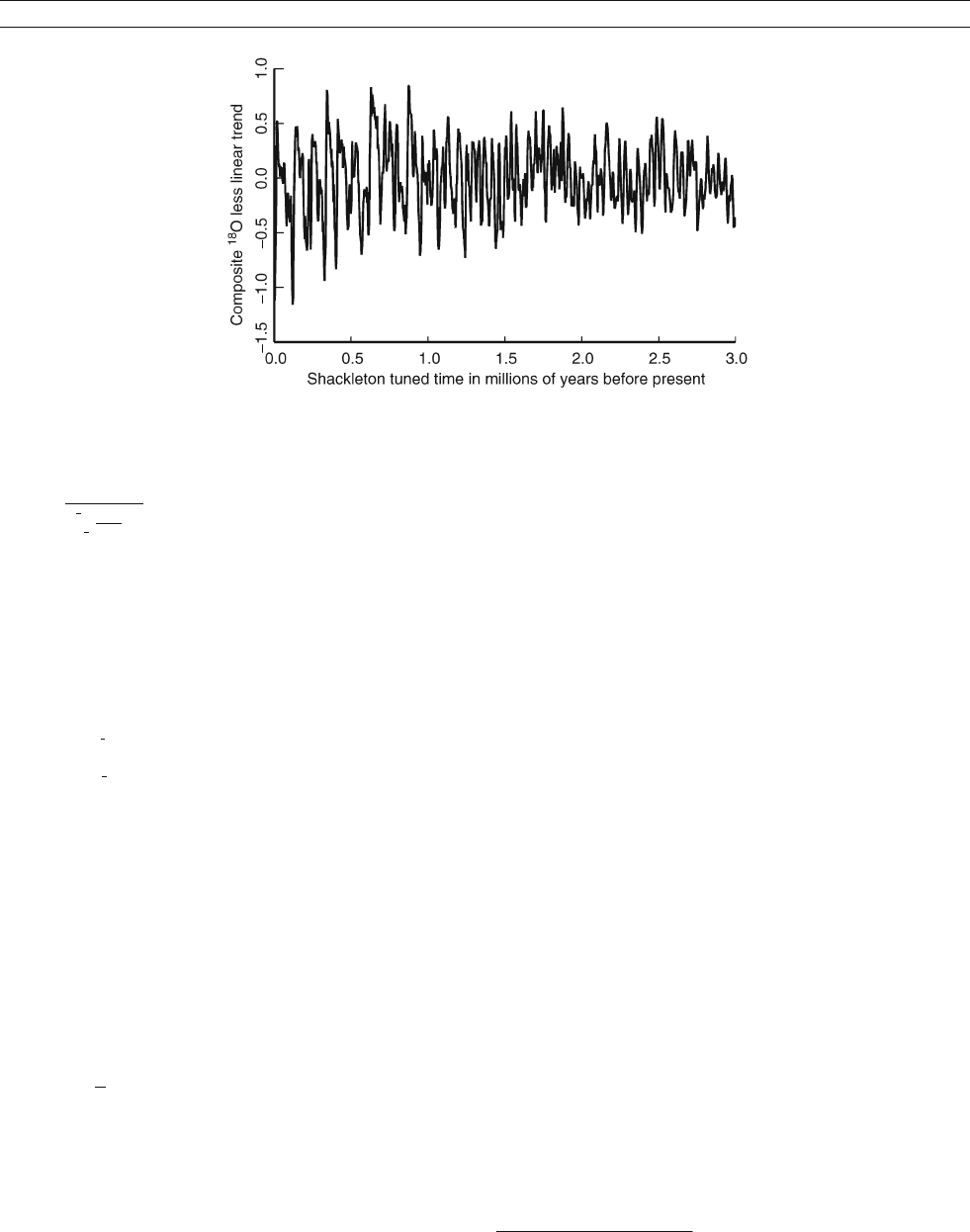
Similarly, the single-sample interpolation variance given by
s
2
I
¼
1
R
1
2
1
2
1
Sðf Þ
df
ð3Þ
shows that a missing sample may be interpolated with an accu-
racy approaching that of the measurement error. Together,
equations (1), (2), and (3) are the arithmetic, geometric, and
harmonic means of the spectrum, respectively.
The autocovariance function,
RðtÞ¼EfxðtÞxðt þ tÞg ð4Þ
is the Fourier transform of the spectrum
RðtÞ¼
Z
1
2
1
2
e
i2pf t
Sðf Þdf ð5Þ
so, comparing (1) and (5), R(0) = s
2
. The autocorrelations,
r(t) are just the autocovariances normalized by the variance
r(t)=R(t)/s
2
and are, as the name implies, the correlation of
the process with delayed versions of itself. The Fourier trans-
form of the autocovariance is the spectrum. Experience shows
that the autocovariance is useful for prediction and interpola-
tion. Even though the autocovariance and spectrum carry
equivalent information, plots of the autocorrelation are usually
remarkably uninformative. (John Tukey remarked that “I only
knew one man who could look at an autocorrelation function
and make sense of it, and he’s dead.”) One useful formula is
that for the zero-crossing rate, the expected number of zeroes
per sample (Kedem, 1994),
EfR
z
g¼
1
p
arccosðrð1ÞÞ ð6Þ
As an example, the Lag–1 correlation of the data shown in
Figure T6 is 0.978 with (6) evaluating to 0.0668, so one
expects the curve to cross its average about every 15 samples
or so.
Since the true spectrum is not known, the best estimate pos-
sible of a spectrum must be made. In estimating a spectrum,
there are several competing criteria to optimize: bias, frequency
resolution, variance, efficiency, ability to distinguish periodic
from non-periodic components, minimum assumptions, and
robustness. The spectrum is, of course, not the only useful
function and one should always plot the raw data and ancillary
functions such as histograms, plots of x(t) vs x(t 1), Q-Q
plots, as well as basic data checks such as histograms of bit
and digit frequencies. Also, if the data is nonstationary (as
much climate data is) one plots a spectrogram, see below, basi-
cally a sequence of spectrum estimates, usually computed on
overlapping time segments and displayed as a function of both
time and frequency.
Estimating the spectrum
As a data example, one can use the first 3 Myr of Shackleton’s
composite benthic
18
O data from V19-30, ODP 677, and ODP
846 (see Shackleton et al., 1990, 1995a,b)
1
. The time step was
scaled by a factor of the ratio 41090.0/41234.9 to bring the
strong obliquity line frequency into exact agreement with
Laskar (1990). For the 3 Myr period being studied, this may
be the most accurate orbital frequency available, see Laskar
(1999). Assuming that a timescale has been established (see
Pälike and Shackleton, 2000), and N data samples, x(t), are avail-
able at a time-spacing of Dt years, the preferred method of esti-
mating the power spectrum is the multitaper method. While the
details of this method has been described in a series of papers
(Thomson, 1982, 1990a,b, 2001; Thomson et al., 2007), and
several books (Percival and Walden, 1993; Rao et al., 2003;
Weedon, 2003), the basic idea is simple and consists of the fol-
lowing steps:
1. Choose the time–bandwidth product controlling frequency
resolution and bias,
c
o
¼ NW ¼ BT ¼ B NDt ð7Þ
so, at unit sampling rate the bandwidth, W,isW = c
o
/N or, in
physical units one has B = c
o
/T where T is the total duration
of the data sample, T = NDt. Usually one should choose
2 c
o
10 and, for most paleoclimate data sets, a choice
of 4 or 5 is a reasonable starting point. In this example
c
o
= 5 was used.
Figure T6 Shackleton’s composite benthic d
18
O record, minus a linear trend, for the past 3 Myr.
1
The data was obtained from //delphi.esc.cam.ac.uk/ coredata/ v677846.
html and the few gaps interpolated; see Appendix A of Thomson et al.
(2001).
950 TIME–SERIES ANALYSIS OF PALEOCLIMATE DATA

The time–bandwidth product, c
o
, is the dimension of
the space of duration T and bandwidth T and to represent
the information in such a space one needs c
o
bases functions.
It is convenient to work with real-valued bases functions,
with the result that the true bandwidth spans the range
from B to + B and consequently one has a space of dimen-
sion 2BT. Thus one has a set of K 2BT bases sequences that,
in spectrum estimation problems, have historically been
known as data windows or data tapers. A typical choice is
K =2c
o
2, or 2NW 2 so if, takes c
o
= 5 as we do here,
one would use K = 8 windows.
The choice of c
o
is fairly critical: if c
o
is too small the esti-
mate will have a high variance and relatively poor bias pro-
tection, but if c
o
is too large, one will have poor frequency
resolution. In this example values of the spectrum go from
aminimumof 15 to a maximum of 4.7 10
4
, a range
of 3,000, so extreme bias protection is not required.
2. Compute the first K lowest order discrete prolate spheroidal
sequences or Slepian sequences, v
(k)
t
(N,W) where 0 t
N 1. These sequences (Slepian, 1978), have the greatest
possible energy concentration within the frequency band
(W,W) of any time-limited sequence and, in sampled data,
define the time–frequency uncertainty principle. They are
defined by the algebraic eigenvalue equation
l
k
ðN; WÞv
ðkÞ
t
ðN; WÞ¼
X
N1
m¼0
sin 2pWðt mÞ
pðt mÞ
v
ðkÞ
m
ðN; WÞð8Þ
The eigenvalues, l
k
(N,W), define the energy concentration in
(W,W). The first K b2NWcare close to one and are the ones
used in spectrum estimation. Although the Slepian sequences
are defined by (8), this is emphatically not the way to compute
them; see Appendix B of Thomson (1990a). For the rest of
this article, the explicit dependence on N and W in the
sequences and eigenvalues is dropped and l
k
and v
(k)
t
are used.
3. Subtract the mean, and possibly trend, from the data
denoted x(t).
4. For k = 0,1,...,K 1 compute the eigencoefficients
x
k
ðf Þ¼
X
N1
n¼0
xðnÞv
ðkÞ
n
e
i2pnf
ð9Þ
Normally the eigencoefficients are computed using a zero-
padded fast Fourier transform (FFT). The procedure is:
(a) Choose the number of transform points M N and
usually M N. The proper choice depends on how good
the signal-to-noise ratio of your data is, with better data
requiring larger M. It is generally unwise to choose
M < 2N. For paleoclimate data, the choice M = N is
almost always a poor one as it implies circular correla-
tions. (This means that the sample autocovariances
obtained by taking the Fourier transform of the spectrum
estimate, the sample equivalent of (5), would include both
“legitimate” terms such as x(n)x(n + t)and“illegitimate”
ones such as x(n)x(n + t N) where the end of the sam-
ple wraps around and is correlated with the start.) The
efficiency of the FFT algorithm depends on M being fac-
torable into small primes, so choosing M as a product of
2’s, 3’s, 5’s, and other small primes up to 19 is necessary.
Also note that, if one has a few hundred data points and
the estimated spectrum differs noticeably between the
choice of M =4000=2
5
5
3
and M =4096=2
12
,
you are likely doing something wrong.
(b) Multiply the data by the k
th
taper. If one is using a stan-
dard (Singleton, 1969) FFT, say FFT(M,X,Y) where X
and Y are arrays of length M, X being the real part
and Y the imaginary, one sets
X ðnÞ¼
xðnÞv
ðkÞ
n
0 n N – 1,
0N n M – 1
ð10Þ
YðnÞ¼00 n M 1 ð11Þ
The FFT computes
X
out
ðjÞþiY
out
ðjÞ¼
X
M1
n¼0
½X
in
ðnÞþiY
in
ðnÞe
i2p
nj
M
ð12Þ
for j =0,...M 1. Because the data encountered in
paleoclimate work is usually real-valued, it is only
necessary to keep the outputs for positive frequencies,
that is for j =0,1,...,M/2. Taking the time at t he n
th
sample to be t
n
= nDt and the frequency at the j
th
FFT bin as f
j
= jdf and comparing exponents it is
evident that
df ¼
1
MDt
ð13Þ
so the effect of zero padding is simply to compute the
frequencies on a finer grid. Note that one occasionally
sees statements to the effect that “aFFTwasnotused
and the Fourier transform was computed exactly.” This
is a fallacy: not only is the FFT far quicker than naive
evaluation of the formula, but it also computes exactly
what it claims to compute and, because it uses far few
operations to do it, suffers less from roundoff error than
direct evaluation of the formula.
5. In practice one estimates the spectrum by solving (17)
below, but to understand the properties of a multitaper
estimate, it is easier to use the approximation
Sðf Þ¼
1
K
X
K1
k¼0
jx
k
ðf Þj
2
ð14Þ
on the grid of frequencies f
j
= jdf, j = 0,1,...,M/2. This
estimate has the following properties:
(a) The bandwidth is
B ¼
c
o
T
¼
c
o
NDt
ð15Þ
Specifically, given a pure sinusoid at frequency f
o
, one-
half of the energy in the sinusoid would be distributed
across the band (f
o
W, f
o
+ W), and the other half of
the energy across the symmetric band (f
o
W, f
o
+
W ). As will be described in the next section, when sinu-
soids are known to be present, one can estimate their fre-
quencies much more accurately than B.
(b) Under reasonable conditions the estimate (14) will have
a chi-squared distribution with 2K degrees-of-freedom,
written w
2K
2
. At frequencies where there is a periodic, or
other narrow-band component, the distribution will be a
non-central chi-square, while at frequencies between such
components i.e., at frequencies where the signal is noise-
like, the distribution is central chi-square. It is safer to
TIME–SERIES ANALYSIS OF PALEOCLIMATE DATA 951

estimate the variance by using a jackknife than by relying
on classical distribution theory. See below for details.
As standard practice, both the classical and jackknife
estimates and are computed and compared.
(c) The bias of the estimate, the energy leaking into the
band ( f W, f + W) through the sidelobes of the win-
dows, can be bounded by
Bðf Þ <
1
K
ð1 l
K1
Þs
2
ð16Þ
where l
k
is the eigenvalue of the k
th
Slepian sequence
defined in (8), and s
2
the process variance.
Finally, while (14) is easy to describe, in practice one uses an
adaptively weighted estimate. Details are given in Thomson
(1982) or on p 546 of Thomson (1990a), but the critical step
is to solve
X
K1
k¼0
l
k
ð
^
Sðf Þjx
k
ðf Þj
2
Þ
½l
k
^
Sðf Þþð1 l
k
Þs
2
2
¼ 0 ð17Þ
for
^
Sðf Þ. It can be shown that this solution is between
min
k
{jx
k
( f )j
2
} and max
k
{jx
k
( f ) j
2
} and, in practice, an iterative
solution starting at
^
Sðf Þ¼ðjx
0
ðf Þj
2
þjx
1
ðf Þj
2
Þ=2 usually
converges in 2 or 3 iterations. The properties are very similar
to those listed above except that, with (17), the effective
degrees-of-freedom will be frequency dependent and usually
lower near the minimum of the spectrum. This loss of
degrees-of-freedom can be reduced by prewhitening.
Lines and Crame
´
r–Rao bounds
A source of confusion in the analysis of paleoclimate data (and
elsewhere) is the distinction between the continuous and line
components of the spectrum. The lines are isolated periodic
components such as those occurring in the familiar, e.g., Berger
(1977, 1978), trigonometric expansions of eccentricity, obli-
quity, and precession, that is, sinusoids at discrete frequencies.
The continuous part of the spectrum is basically everything
else: measurement errors and related problems such as biotur-
bation, and non-deterministic parts of the climate process with
a short prediction horizon.
The basic multitaper estimate for periodic components can
be understood by considering the effects of a single sinusoid
in noise. Define
yðtÞ¼xðtÞþA cosð2pf
0
t þ fÞð18Þ
which can be written
yðtÞ¼xðtÞþ
A
2
e
if
e
i2pf
0
t
þ
A
2
e
if
e
i2pf
0
t
; ð19Þ
where A2e
if
¼ m is the complex amplitude and x(t) is assumed
to be non-periodic. The eigencoefficients of y(t) are
y
k
ðf Þ¼x
k
ðf ÞþmV
k
ðf f
0
Þþm
V
k
ðf þf
0
Þð20Þ
where V
k
( f ) is the Slepian function
V
k
ðf Þ¼
X
N1
n¼0
v
ðkÞ
n
e
i2pfn
ð21Þ
Because of the energy concentration properties of the Slepian
sequences, the term m
∗
V
k
( f + f
0
) can usually be ignored if
f
0
> W. Because it is assumed that x(t) is a zero-mean process,
the expected value
Efy
k
ðf Þg ¼ mV
k
ðf f
0
Þð22Þ
One does a formal hypothesis test for the presence of a periodic
component. The null hypothesis, H
0
, is that the frequency band
(f W, f + W) has an approximately flat (called “locally
white”) spectrum of unknown power. The alternative hypoth-
esis, H
1
, is that in addition to the locally white noise, there is
a sinusoid at frequency f. Estimate its amplitude m by least-
squares, that is minimize the error at frequency f between the
data, the y
k
( f )’s, and the model, (22). For an assumed complex
amplitude
^
mðf Þ, the error is
E
2
ðf ;
^
mðf ÞÞ ¼
X
K1
k¼0
jy
k
ðf Þ
^
mðf ÞV
k
ð0Þj
2
; ð23Þ
where the assumption that the line frequency f
0
= f results in the
zero argument of the Slepian function. Taking the partial deri-
vative of E with respect to
^
mðf Þ
, one obtains
^
mðf Þ¼
P
K1
k¼0
y
k
ðf ÞV
k
ð0Þ
P
K1
k¼0
jV
k
ð0Þj
2
; ð24Þ
the regression of the eigencoefficients on their expected values.
One tests this regression in the usual way by using an F–test.
This is the ratio of the energy explained by the assumed
periodic component at frequency f to that remaining in the
residuals,
Fðf Þ¼
1
2
j
^
mðf Þj
2
P
K1
k¼0
jV
k
ð0Þj
2
1
2K2
E
2
ðf ;
^
mðf ÞÞ
: ð25Þ
To understand this equation, recall that an F–statistic is defined
as (w
p
2
/p)/(w
q
2
/q) where w
p
2
and w
q
2
are independent chi-squared
variables of p and q degrees-of-freedom, respectively. If there
is no periodic component present, just “noise”, then, because
^
mðf Þ is complex, j
^
mðf Þj
2
is chi-squared with two degrees-of-
freedom. The residual, E
2
, has 2K 2 degrees-of-freedom
and is independent of the estimated mean, so F( f ) has a central
F-distribution under H
0
.
It can be shown by some tedious algebra that if one uses the
frequency where F( f ) is maximized as an estimate of f
0
,itis
usually within a few percent
2
of the Cramér–Rao bound on
the achievable accuracy of a frequency estimate.
Notes on the har monic F–test
When interpreting F -tests for lines, some precautions should be
observed.
1. Because the F-test is computed as a function of frequency,
there are approximately N independent tests in the fre-
quency domain. Thus one should expect some false detec-
tions. For example, if one adopts a conventional 95%
level, one should expect about 0.05N “detections” in cases
when there are no lines present.
2. When there are strong lines present, the single-line F-test
given above will suppress false detections within W of
these lines.
2
The actual factor is the estimate efficiency X defined in Thomson (1982)
}VII.
952 TIME–SERIES ANALYSIS OF PALEOCLIMATE DATA
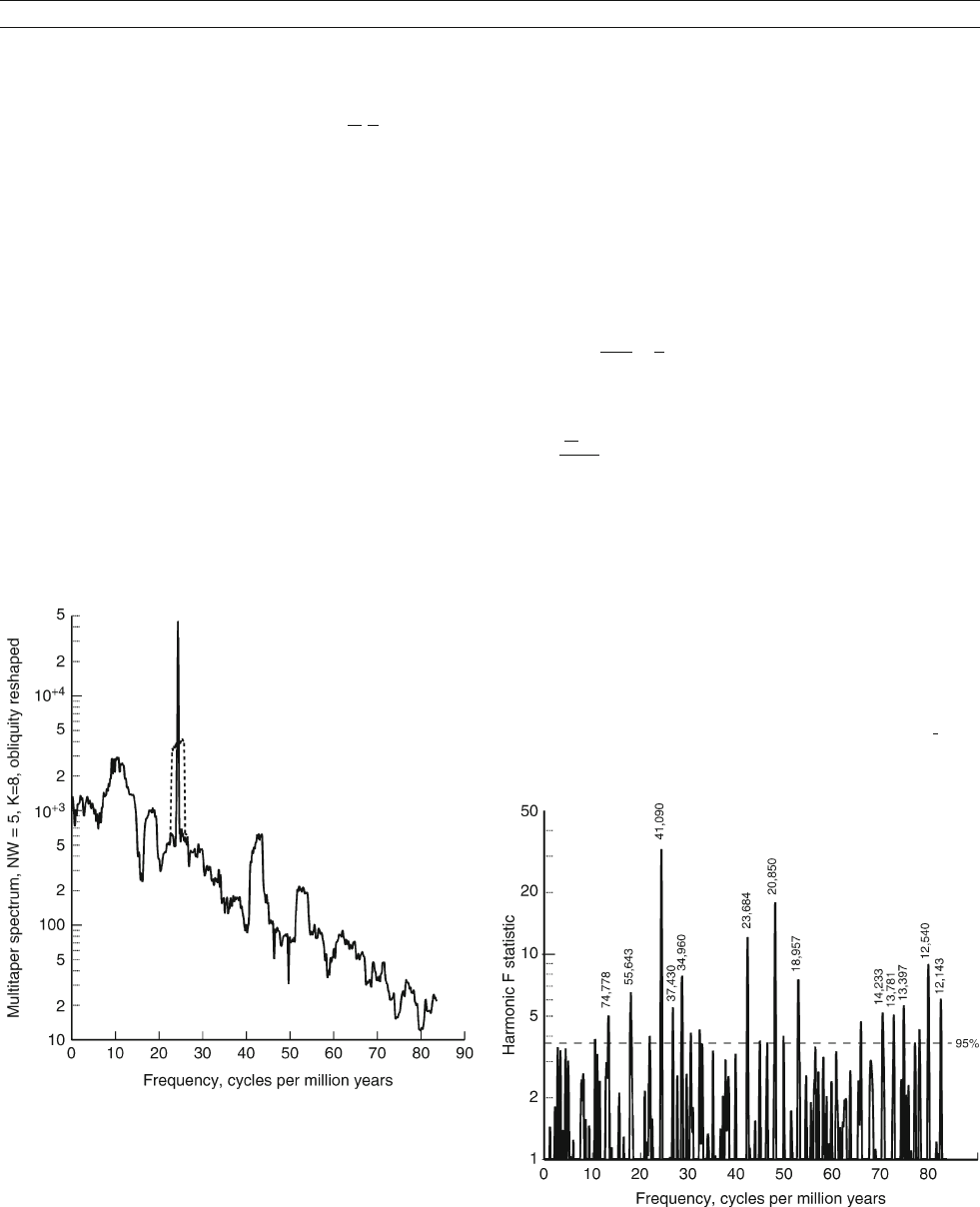
3. The test is sensitive to departures in assumptions. For exam-
ple, an amplitude or phase modulated sinusoid will usually
be rejected if the amplitude varies by a factor of two over
the sample interval, or if the frequency,
1
2p
d
dt
f, varies by
about one-third of a Rayleigh resolution, that is, 1/(3T ).
4. The test usually rejects multiple lines within the band.
5. When one observes a roughly rectangular peak of total
width ⪆ 2W in the spectrum without a peak in the F-test
at the center frequency of the peak, one should test for mul-
tiple lines or for a modulated periodic component. (The
lower precession band in Figure T8 is typical; this band,
42–45 c/Myr, contains four strong lines of which two are
detected.) Tests are described in Thomson (1990a) and
Johnson et al. (1996).
6. A peak in the F-test corresponding to a local minimum in
the spectrum is usually a false detect. The line marked
“20,850” in Figure T8 is almost certainly in this category.
Similarly, the lines marked “13,397,” and “12,540” may be
false detections, but could be a nonlinear interaction
between obliquity and precession. Similarly, maxima in
F on the sides of peaks, or on very steep slopes, are often
false detections. The line marked “37,430” in Figure T8 is
on the shoulder of the obliquity band. The reason for these
false detections is that the “locally white” condition is
violated, causing the y
k
’s to be correlated.
7. When a sharp peak in the F–test occurs near the center of a
roughly rectangular peak of total width 2W,itisusually
reliable. The 41,090-year obliquity line and 18,957-year pre-
cession line are prime examples, but again, the upper preces-
sion band contains lines at several closely-spaced periods.
The Crame
´
r–Rao bound
The Cramér–Rao bound is a fundamental statistical inequality
that gives lower limits on the accuracy with which various
quantities can be estimated; here the frequency. For a single,
isolated line, i.e., one that is isolated from other lines by at least
max(2,c
0
)/T, the bound is approximately
SDf
^
f g
1
2pT
ffiffiffi
6
r
s
ð26Þ
where r is the effective signal-to-noise power ratio,
r ¼
A
2
4
T
S
c
ðf Þ
ð27Þ
where S
c
( f ) is the noise spectrum. This is the spectrum without
the periodic components; in Figure T7 the noise spectrum near
the 41,000 year obliquity line is about 500. Combining (26)
and (27) it can be seen that, other things being equal, the var-
iance of a frequency estimate decreases as T
3
. Thus, when a
choice can be made, effort should be made obtaining longer
series, not in making more precise measurements in a shorter
series. As an example, if one wanted to double the accuracy
of a frequency estimate one could consider either making more
precise measurements or increasing the length of the series.
The first choice, implies that s
2
must be reduced by a factor
of four, usually corresponding to a four-fold increase in mea-
surement effort. The second requires increasing T by
ffiffiffi
2
1
3
p
,or
Figure T7 A multitaper estimate of the spectrum of the 3 Myr record
shown in Figure T6. In making this estimate, c
o
= NW = 5.0 with K =8
windows were used with adaptive weighting, (17). The dashed curve
near 25 c /Myr (the 41090-year obliquity line) is the “raw” spectrum
estimate, while the sharp black curve is the “reshaped” estimate.
Because the significance level of the F–test exceeded the 99.999% level,
the raw estimate was replaced with a peak at the estimated frequency.
The width of the peak is given by the estimated frequency uncertainty,
and the height is scaled to preserve power. The precession peaks (near
43 and 52 c / Myr) were not reshaped because they both consist of
multiple lines and the eccentricity lines (7.8 – 10.5 c /Myr) are not
resolved.
Figure T8 The single-line F –test for periodic components, (25). The
data is the 3 Myr record shown in Figure T6, with parameters are as
in Figure T7, so the test has 2 and 14 degrees-of-freedom. The
low-frequency part is shown in Figure T10 and the horizontal dashed
line shows the theoretical 95% level of the F
2,14
distribution.
TIME–SERIES ANALYSIS OF PALEOCLIMATE DATA 953
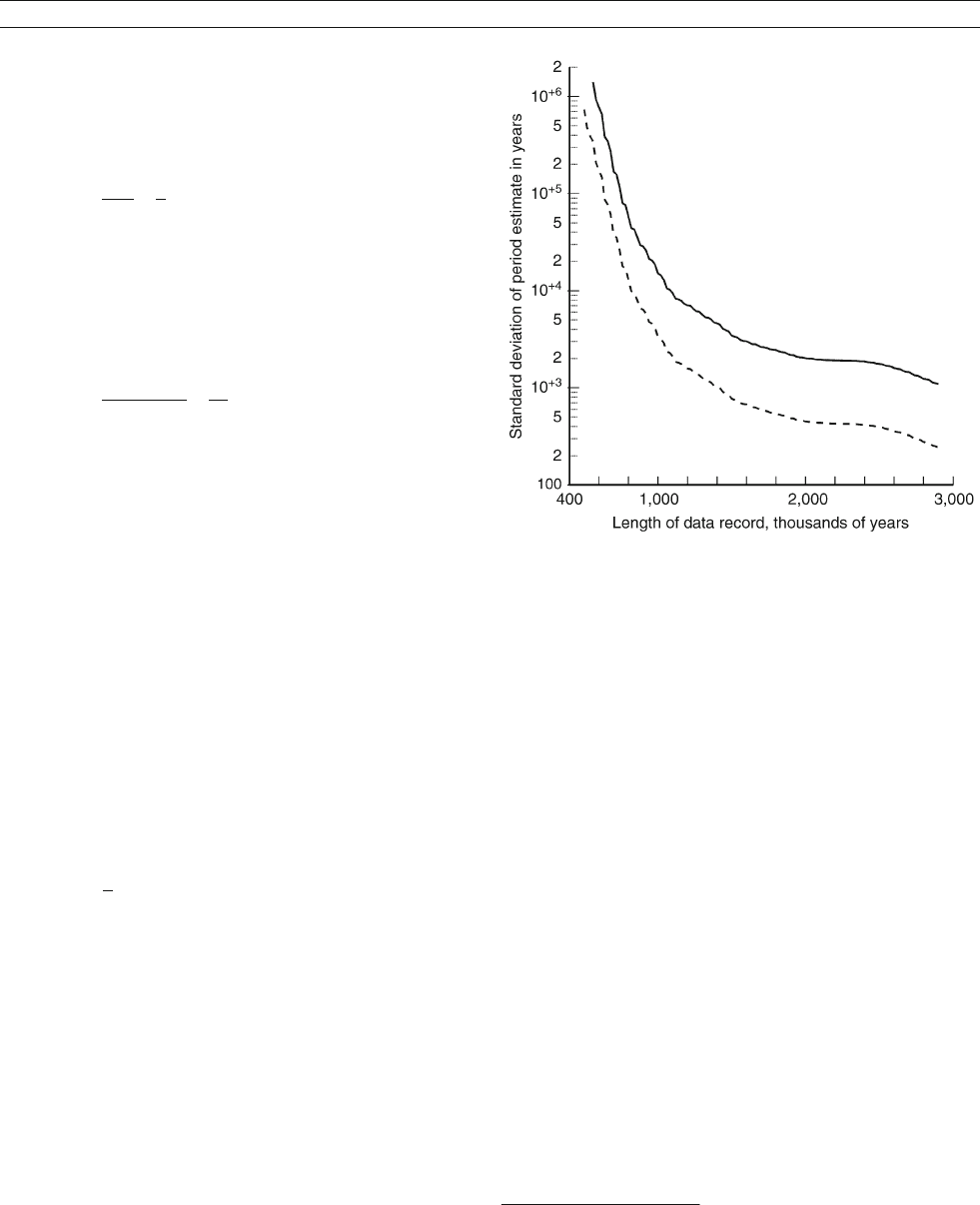
about 26% more samples. Note that this calculation ignores the
tuning problem.
If one is interested in estimating the period of a component,
as is common in paleoclimate data, a Taylor’s series argument
shows that (26) becomes
SDf
^
Pg
P
2
2pT
ffiffiffi
6
r
s
ð28Þ
The F–test on the 41,000 year obliquity line was 30, and can
be used as an estimate of r. Thus, if one oversimplifies things
to ignore fine structure, possible frequency-modulation from
changes in the earth’s moments of inertia (see }11 of Thomson
(1990a) and Figure T14 of Laskar et al., 1993) the accuracy of
any estimate of the period from the 3 Myr record is bounded by
SDf
^
Pg
41000
2
2p 3 10
6
ffiffiffiffiffi
6
30
r
38 years ð29Þ
Because the period estimated from the original time scale was
41,234.9 years, 3.8 standard deviations from the nominal per-
iod of 41,090 years, the time was scaled by a factor of
41090.0/41234.9 to bring the two into agreement.
Equation (28) has further implications for data analysis.
Because the Cramér–Rao bound is a fundamental statistical
inequality, it does not apply to one particular estimation method
or another, it simply says that one cannot estimate parameters
with arbitrary accuracy. Arguments based on wavelet analysis
of paleoclimate data claim that the precession line is frequency
modulated. The usual trigonometric expansions used in celes-
tial mechanics are, in fact, the Bessel function expansions of
a frequency-modulated sinusoid. Since wavelets sequentially
use data blocks half the length of the preceding one, the effec-
tive T in (28) at a given stage is much less than the length of
the series. Thus (28) implies that the standard deviation will
be proportionally larger, negating the argument.
Equation (26) also determines the amount of zero-padding
necessary. A minimum requirement is that the frequency mesh,
(13), should be less than about one-half the standard deviation
implying
M ⪆ 4p
ffiffiffi
r
6
r
N ð30Þ
For the 3 Myr series this implies that the 1,000 samples should
be zero-padded to 2M ⪆ 28,000 points and, in fact, these
examples were zero-padded to 2M =2
17
= 131,072.
When lines are not isolated and, in particular, when they are
separated by less than twice the Rayleigh resolution, computing
the bounds is more difficult. The bounds depend on the amplitudes
and phases of the lines in addition to the frequency separation.
Looking at the eccentricity expansions, there are four major lines
with periods near 100,000 years. They are, explicitly, 94,782,
98,715, 123,818, and 130,615 years. Note that these come in
two pairs; the frequency difference between the two frequencies
in the first pair and those in the second both correspond to a period
of 2.4 Myr. This means that estimating these frequencies with less
than 4.8 Myr of data will be difficult even in utopian circum-
stances. Figure T9 shows the bounds for the four-line case com-
puted using the frequencies, phases, and amplitudes from Berger
(1977) as a function of the observation span. Note that, when the
data span is less than 800,000 years, the bound on the standard
deviation is 100,000 years, about the same as the period. Note also
that these bounds are for Gaussian noise with a known timescale;
when the timescale is estimated the bounds will be worse. More-
over, four pure sinusoids are assumed, whereas the eccentricity
expansion includes dozens of lines in this band so, again, the
bounds will be even worse than shown here. Thus, for example,
attempts to discriminate between frequencies of 77,000 years
and 95,000 lines with less than a few million years of data are
futile. (It may be futile even with a few million years of data
because 4.8 Myr is long enough for continental drift to signifi-
cantly change climate dynamics.)
The multitaper setup for multiple lines is discussed in
Thomson (1990a), and an example using the above data is
shown here in Figure T10. The two-line test used here assumed
a known frequency offset between the two lines, 1/2.2379
10
6
cycle/year, but even with this assumption, the test is only
significant at about the 97% level.
Coherence
Many analysis problems in paleoclimate data involve studying
several different series. The simplest case is the bivariate one,
that is where one has two time series, x(t) and y(t). These are
assumed to be on the same timescale, are sampled at the same
time-step, and have the same number of samples
3
. Keeping the
Figure T9 The Crame
´
r–Rao lower bound for the standard deviation of
the 123,000-year eccentricity line as a function of sample duration. A
uniform sampling rate of Dt = 1, 000 years is assumed. The upper curve
corresponds to a signal-to-noise ratio r = 5, the lower to an
unrealistically high value of 100. For a perfectly-tuned 800 Kyr record
the standard deviation of the best period estimate is about the same as
the period.
3
If the time-steps and number of samples are different one can still do the
analysis as long as the total time span is the same and, obviously, one can
always truncate a longer series. The frequencies used must be the same, so it
may be necessary to use a “slow” Fourier transform (see e.g., Gentleman,
1969).
954 TIME–SERIES ANALYSIS OF PALEOCLIMATE DATA
